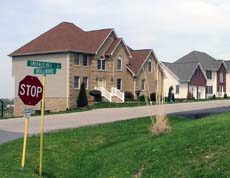index
Contemporary Places or Non-Places ?
click on images for full-size:



Simultaneously old and new

Emerald Hills development near Staunton, Virginia
There is a widespread feeling that we are now building non-places: think of malls and subdivisions and theme parks and parking lots. I want to honor that feeling that something is amiss, but deny that way of describing the problem. There's no doubt that many of our newer places have little to recommend them aesthetically. Yet they still are places with social definitions that specify forms of life. Those parking lots around the mall are real places, marked with our activities. They have their usages and modes of inhabitation. When we say that they and their mall are non-places what we are condemning is their simplicity or their thin social roles, but they remain human places. We should not identify places as such with centered, homey locales for unified communities, for if we do, we will approach our world in too limited a way, even as the realities of global markets and communication remake old centered places into multi-connected nodes. Our situation demands imaginative adventures with newer concepts of place and new modes of unity and inhabitation. What I am suggesting aims at improving the concreteness and social thickness of places; improvements to their aesthetic character should follow upon that. Beautiful but oversimplified places are worse than complex junkiness.